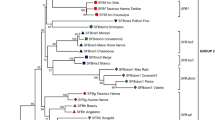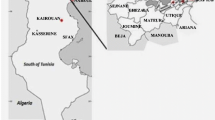Summary
In order to study the extent and nature of differences among various S-allele-associated proteins in N. alata, we carried out comparative studies of seven such proteins. We first isolated and sequenced cDNA clones for the Sz-, SF11-, S1-, and Sa-alleles, and then we compared the deduced amino acid sequences both of these four S-proteins and of three previously published S2-, S3-, and S6-proteins. This comparison revealed (1) an average homology of 53.8% among the seven proteins and (2) two homology classes, with Sz and SF11 in one class and S1, S2, S3, and S6 in the other class. There are 60 conserved residues, including 9 cysteines. Of the 144 variable residues, 50 were identified as hypervariable based on a calculation of their Similarity Indices. Although conserved, variable, and hypervariable residues are dispersed throughout the protein, some are clustered to form five conserved, five hypervariable, and a number of variable regions. Those variable sites which contain residues conserved within one class of S-proteins but different between classes might provide a clue to the evolutionary relationship of these two classes of S-proteins. The hypervariable residues, which account for sequence variability, may contribute to allelic specificity.
Similar content being viewed by others
References
Ai Y, Singh A, Coleman CE, Ioerger TR, Kheyr-Pour A, Kao T-H (1990) Self-incompatibility in Petunia inflata: isolation and characterization of cDNAs encoding three S-allele associated proteins. Sex Plant Reprod 3:130–138
Anderson MA, Cornish EC, Mau S-L, Williams EG, Hoggart R, Atkinson A, Bonig I, Grego B, Simpson R, Roche PJ, Haley JD, Penschow JD, Niall HD, Tregear GW, Coghlan JP, Crawford RJ, Clarke AE (1986) Cloning of cDNA for a stylar glycoprotein associated with expression of self-incompatibility in Nicotiana alata. Nature 321:38–44
Anderson MA, McFadden GI, Bernatzky R, Atkinson A, Orpin T, Dedman H, Tregear G, Fernley R, Clarke AE (1989) Sequence variability of three alleles of the self-incompatibility gene of Nicotiana alata. Plant Cell 1:483–491
Ausubel FM, Brent R, Kingston RE, Moore DD, Seidman JG, Smith JA, Struhl K (1987) Current protocols in molecular biology. Wiley, New York
Bjorkman PJ, Saper MA, Samraoui B, Bennett WS, Strominger JL, Wiley DC (1987) The foreign antigen binding site and T cell recognition regions of class I histocompatibility antigens. Nature 329:512–518
Bredemeijer GM, Blass J (1981) S-specific proteins in styles of self-incompatible Nicotiana alata. Theor Appl Genet 59:185–190
Dayhoff MO, Schwartz RM, Orcutt BC (1979) A model of evolutionary change in proteins. In: Dayhoff MO (ed) Atlas of protein sequence and structure vol 5 [Suppl 3] National Biomedical Research Foundation, Washington DC, pp 345–352
Gubler U, Hoffman BJ (1983) A simple and very efficient method for generating cDNA libraries. Gene 25:263–269
Huynh TV, Young RA, Davis RW (1984) Constructing and screening cDNA libraries in λgtl0 and λgt11. In: Glover D (ed) DNA cloning: a practical approach. IRL Press, Oxford, pp 49–78
Jahnen W, Batterham MP, Clarke AE, Moritz RL, Simpson RJ (1989) Identification, isolation, and N-terminal sequencing of style glycoproteins associated with self-incompatibility in Nicotiana alata. Plant Cell 1:493–499
Kamboj RK, Jackson JF (1986) Self-incompatibility alleles control a low molecular weight, basic protein in pistils of Petunia hybrida. Theor Appl Genet 71:815–819
Kheyr-Pour A, Fernès J (1986) A new S-allele and specific S-proteins associated with two S-alleles in Nicotiana alata. In: Mulcahy DL, Mulcahy GB, Ottaviano E (eds) Biotechnology and ecology of pollen. Springer, Berlin Heidelberg New York, pp 191–196
Labroche P, Poirier-Hamon S, Pernes J (1983) Inheritance of leaf peroxidase isozymes in Nicotiana alata and linkage with the S-incompatibility locus. Theor Appl Genet 65:163–170
Mau S-L, Raff JW, Clarke AE (1982) Isolation and partial characterization of components of Prunus avium L. styles, including an antigenic glycoprotein associated with a self-incompatibility genotype. Planta 156:505–516
Mau S-L, Williams EG, Atkinson A, Anderson MA, Cornish EC, Grego B, Simpson RJ, Kheyr-Pour A, Clarke AE (1986) Style proteins of a wild tomato (Lycopersicon peruvianum) associated with expression of self-incompatibility. Planta 169:184–191
Nasrallah ME, Wallace DH (1967) Immuno-genetics of self-incompatibility proteins: detection, genetics and possible mode of action. Heredity 22:519–527
Nasrallah JB, Kao T-H, Goldberg ML, Nasrallah ME (1985) A cDNA clone encoding an S-locus-specific glycoprotein from Brassica oleracea. Nature 318:263–267
Nasrallah JB, Kao T-H, Chen C-H, Golderberg ML, Nasrallah ME (1987) Amino acid sequence of glycoproteins encoded by three alleles of the S-locus of Brassica oleracea. Nature 326:617–619
Nettancourt D de (1977) Incompatibility in angiosperms. In: Frankel R, Gall GAE, Linskens HF (eds) Monographs on theoretical and applied genetics, vol 3. Springer, Berlin Heidelberg New York
Nishio T, Hinata K (1978) Stigma proteins in self-incompatible Brassica campestris L. and self-compatible relatives, with special reference to S-allele-specificity. Jpn J Genet 53:27–33
Nishio T, Hinata K (1982) Comparative studies on S-glycoproteins purified from different S-genotypes in self-incompatible Brassica species. I. Purification and chemical properties. Genetics 100:641–647
Pandey KK (1964) Elements of the S-gene complex. I. The SFI alleles in Nicotiana. Genet Res 2:397–409
Takayama S, Isogai A, Tsukamoto C, Ueda Y, Hinata K, Okazaki K, Suzuki A (1987) Sequences of S-glycoproteins, products of the Brassica campestris self-incompatibility locus. Nature 326:102–105
Xu B, Grun P, Kheyr-Pour A, Kao T-H (1990) Identification of pistil-specific proteins associated with three self-incompatibility alleles in Solanum chacoense. Sex Plant Reprod 3:54–60
Author information
Authors and Affiliations
Rights and permissions
About this article
Cite this article
Kheyr-Pour, A., Bintrim, S.B., Ioerger, T.R. et al. Sequence diversity of pistil S-proteins associated with gametophytic self-incompatibility in Nicotiana alata . Sexual Plant Reprod 3, 88–97 (1990). https://doi.org/10.1007/BF00198851
Issue Date:
DOI: https://doi.org/10.1007/BF00198851




